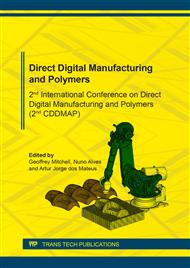[1]
A. J. V. Pontes, SHRINKAGE AND EJECTION FORCES IN INJECTION MOULDED PRODUCTS, Minho, (2002).
Google Scholar
[2]
J. MALLON, Advances in Automation for Plastics Injection Moulding,, Shropshire, (2001).
Google Scholar
[3]
J. Williams, Injection Molding Cooling Time: A Breakdown.
Google Scholar
[4]
V. G, R. K. Y and R. G, Comparison of Straight Line to Conformal Cooling Channel in Injection Molding,, materialstoday: PROCEDINGS, vol. 4, (2017).
Google Scholar
[5]
R.-Y. Zhang, W. Yang, J.-J. Wu, J. Feng, J.-M. Feng, B.-H. Xie and M.-B. Yang, Hierarchically oriented crystalline structures of HDPE induced by strong second melt penetration,, The Royal Society of Chemistry, (2014).
DOI: 10.1039/c4ra03404j
Google Scholar
[6]
Autodesk, The Causes of Warpage,, [Online]. Available: https://www.autodesk.com/industry/ manufacturing/resources/injection-molding/causes-of-warpage.
Google Scholar
[7]
B. Clark, Fundamentals of Designing the Optimal Cooling System,, MoldMaking Technology, 12 1 (2014).
Google Scholar
[8]
K. Yaji, T. Yamad, S. Kubo, K. Izui and S. Nishiwaki, A topology optimization method for a coupled thermal–fluid problem using level set boundary expressions,, International Journal of Heat and Mass Transfer, vol. 81, pp.878-888, (2015).
DOI: 10.1016/j.ijheatmasstransfer.2014.11.005
Google Scholar
[9]
SLM-Solutions, Selective Laser Melting Machine SLM 500,, [Online]. Available: https://slm-solutions.com/products/machines/selective-laser-melting-machine-slm-500.
DOI: 10.18297/etd/1205
Google Scholar
[10]
INEOS Olefins & Polymers USA, Polypropylene Processing Guide,, 2007. [Online]. Available: https://www.ineos.com/globalassets/ineos-group/businesses/ineos-olefins-and-polymers-usa/products/technical-information--patents/ineos_polypropylene_processing_guide.pdf.
DOI: 10.12968/s0306-3747(23)70039-0
Google Scholar
[11]
A. Sobashkin and G. Dumnov, Numerical Basis of CAD-Embedded CFD,, February 2014. [Online].
Google Scholar
[12]
HRS heat exchangers, Comparison of Laminar and Turbulent Flow,, 17 August 2016. [Online]. Available: https://www.hrs-heatexchangers.com/resource/comparison-laminar-turbulent-flow.
Google Scholar


